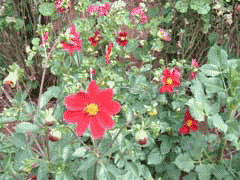 |
|
http://commons.wikimedia.org/wiki/User:Conrado |
 |
|
Translate this page:
Summary
Physical Characteristics

 Dahlia pinnata is a PERENNIAL growing to 1 m (3ft 3in).
Dahlia pinnata is a PERENNIAL growing to 1 m (3ft 3in).
See above for USDA hardiness. It is hardy to UK zone 9 and is frost tender. It is in flower from June to October. The species is hermaphrodite (has both male and female organs) and is pollinated by Insects.
Suitable for: light (sandy), medium (loamy) and heavy (clay) soils. Suitable pH: mildly acid, neutral and basic (mildly alkaline) soils. It cannot grow in the shade. It prefers moist soil.
UK Hardiness Map
US Hardiness Map
Synonyms
D. variabilis.
Plant Habitats
Cultivated Beds;
Edible Uses
Edible Parts: Flowers Root
Edible Uses: Condiment Sweetener
The flower petals are used in salads[177]. Root - cooked and used as a vegetable[183]. A bitter flavour[200]. A sweet extract of the tuber, called 'dacopa', is used as a beverage or as a flavouring. It is mixed with hot or cold water and sprinkled on ice cream. Its naturally sweet mellow taste is said to combine the characteristics of coffee, tea and chocolate[183]. The root is rich in the starch inulin. Whilst not absorbed by the body, this starch can be converted into fructose, a sweetening substance suitable for diabetics to use[141, 171].
References More on Edible Uses
Medicinal Uses
Plants For A Future can not take any responsibility for any adverse effects from the use of plants. Always seek advice from a professional before using a plant medicinally.
None known
References More on Medicinal Uses
The Bookshop: Edible Plant Books
Our Latest books on Perennial Plants For Food Forests and Permaculture Gardens in paperback or digital formats.

Edible Tropical Plants
Food Forest Plants for Hotter Conditions: 250+ Plants For Tropical Food Forests & Permaculture Gardens.
More

Edible Temperate Plants
Plants for Your Food Forest: 500 Plants for Temperate Food Forests & Permaculture Gardens.
More

More Books
PFAF have eight books available in paperback and digital formats. Browse the shop for more information.
Shop Now
Other Uses
Dye
An orange dye is obtained from the flowers and seed heads[168, 169].
Special Uses
References More on Other Uses
Cultivation details
An easily grown plant so long as the soil does not dry out[260]. It requires a deep rich soil and a sunny position[164], disliking shade[200]. The growing plant is very frost-tender, though the tubers are somewhat hardier tolerating temperatures down to about -5°c[260]. However, these tubers are not reliably hardy if left in the ground over winter in Britain[200]. They are best harvested after the foliage is killed off by frost and then stored in a cool but frost-free place over the winter, planting out in April/May[200].
References Carbon Farming Information and Carbon Sequestration Information
Temperature Converter
Type a value in the Celsius field to convert the value to Fahrenheit:
Fahrenheit:
The PFAF Bookshop
Plants For A Future have a number of books available in paperback and digital form. Book titles include Edible Plants, Edible Perennials, Edible Trees,Edible Shrubs, Woodland Gardening, and Temperate Food Forest Plants. Our new book is Food Forest Plants For Hotter Conditions (Tropical and Sub-Tropical).
Shop Now
Plant Propagation
Seed - sow late winter to mid spring in a greenhouse. The seed usually germinates in 1 - 3 weeks at 20°c[164]. When they are large enough to handle, prick the seedlings out into individual pots and grow them on in the greenhouse for at least their first winter. Plant them out into their permanent positions in late spring or early summer, after the last expected frosts. Cuttings of young shoots in early spring. The tubers are usually brought into the greenhouse in late winter in order to encourage early growth and young basal shoots are removed as soon as they are large enough[200]. Division. The roots are usually harvested in the autumn. These can be divided into individual tubers when planting out in the spring. Each portion should have a growing point[200].
Other Names
If available other names are mentioned here
Native Range
Coming Soon
Weed Potential
Right plant wrong place. We are currently updating this section.
Please note that a plant may be invasive in one area but may not in your area so it's worth checking.
Conservation Status
IUCN Red List of Threatened Plants Status :

Growth: S = slow M = medium F = fast. Soil: L = light (sandy) M = medium H = heavy (clay). pH: A = acid N = neutral B = basic (alkaline). Shade: F = full shade S = semi-shade N = no shade. Moisture: D = dry M = Moist We = wet Wa = water.
Now available:
Food Forest Plants for Mediterranean Conditions
350+ Perennial Plants For Mediterranean and Drier Food Forests and Permaculture Gardens.
[Paperback and eBook]
This is the third in Plants For A Future's series of plant guides for food forests tailored to
specific climate zones. Following volumes on temperate and tropical ecosystems, this book focuses
on species suited to Mediterranean conditions—regions with hot, dry summers and cool, wet winters,
often facing the added challenge of climate change.
Read More
Expert comment
Author
Cav.
Botanical References
200
Links / References
For a list of references used on this page please go here
Readers comment
© 2010, Plants For A Future. Plants For A Future is a charitable company limited by guarantee, registered in England and Wales. Charity No. 1057719, Company No. 3204567.